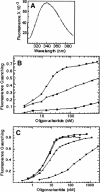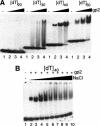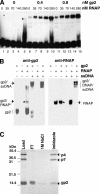Phage N4 RNA polymerase II recruitment to DNA by a single-stranded DNA-binding protein
- PMID: 12975320
- PMCID: PMC196469
- DOI: 10.1101/gad.1121403
Phage N4 RNA polymerase II recruitment to DNA by a single-stranded DNA-binding protein
Abstract
Transcription of bacteriophage N4 middle genes is carried out by a phage-coded, heterodimeric RNA polymerase (N4 RNAPII), which belongs to the family of T7-like RNA polymerases. In contrast to phage T7-RNAP, N4 RNAPII displays no activity on double-stranded templates and low activity on single-stranded templates. In vivo, at least one additional N4-coded protein (p17) is required for N4 middle transcription. We show that N4 ORF2 encodes p17 (gp2). Characterization of purified gp2revealed that it is a single-stranded DNA-binding protein that activates N4 RNAPII transcription on single-stranded DNA templates through specific interaction with N4 RNAPII. On the basis of the properties of the proteins involved in N4 RNAPII transcription and of middle promoters, we propose a model for N4 RNAPII promoter recognition, in which gp2plays two roles, stabilization of a single-stranded region at the promoter and recruitment of N4 RNAPII through gp2-N4 RNAPII interactions. Furthermore, we discuss our results in the context of transcription initiation by mitochondrial RNA polymerases.
Figures







Similar articles
-
Structural and biochemical investigation of bacteriophage N4-encoded RNA polymerases.Biomolecules. 2015 Apr 27;5(2):647-67. doi: 10.3390/biom5020647. Biomolecules. 2015. PMID: 25924224 Free PMC article. Review.
-
Minimalism and functionality: Structural lessons from the heterodimeric N4 bacteriophage RNA polymerase II.J Biol Chem. 2018 Aug 31;293(35):13616-13625. doi: 10.1074/jbc.RA118.003447. Epub 2018 Jul 10. J Biol Chem. 2018. PMID: 29991593 Free PMC article.
-
N4 RNA polymerase II, a heterodimeric RNA polymerase with homology to the single-subunit family of RNA polymerases.J Bacteriol. 2002 Sep;184(18):4952-61. doi: 10.1128/JB.184.18.4952-4961.2002. J Bacteriol. 2002. PMID: 12193610 Free PMC article.
-
Escherichia coli single-stranded DNA-binding protein mediates template recycling during transcription by bacteriophage N4 virion RNA polymerase.Proc Natl Acad Sci U S A. 2003 Aug 5;100(16):9250-5. doi: 10.1073/pnas.1133325100. Epub 2003 Jul 22. Proc Natl Acad Sci U S A. 2003. PMID: 12876194 Free PMC article.
-
Targeting DNA secondary structures.Curr Med Chem. 2000 Jan;7(1):1-15. doi: 10.2174/0929867003375461. Curr Med Chem. 2000. PMID: 10637354 Review.
Cited by
-
'Drc', a structurally novel ssDNA-binding transcription regulator of N4-related bacterial viruses.Nucleic Acids Res. 2020 Jan 10;48(1):445-459. doi: 10.1093/nar/gkz1048. Nucleic Acids Res. 2020. PMID: 31724707 Free PMC article.
-
Structural and biochemical investigation of bacteriophage N4-encoded RNA polymerases.Biomolecules. 2015 Apr 27;5(2):647-67. doi: 10.3390/biom5020647. Biomolecules. 2015. PMID: 25924224 Free PMC article. Review.
-
Pectobacterium versatile Bacteriophage Possum: A Complex Polysaccharide-Deacetylating Tail Fiber as a Tool for Host Recognition in Pectobacterial Schitoviridae.Int J Mol Sci. 2022 Sep 20;23(19):11043. doi: 10.3390/ijms231911043. Int J Mol Sci. 2022. PMID: 36232343 Free PMC article.
-
Novel N4-Like Bacteriophages of Pectobacterium atrosepticum.Pharmaceuticals (Basel). 2018 May 14;11(2):45. doi: 10.3390/ph11020045. Pharmaceuticals (Basel). 2018. PMID: 29757952 Free PMC article.
-
Minimalism and functionality: Structural lessons from the heterodimeric N4 bacteriophage RNA polymerase II.J Biol Chem. 2018 Aug 31;293(35):13616-13625. doi: 10.1074/jbc.RA118.003447. Epub 2018 Jul 10. J Biol Chem. 2018. PMID: 29991593 Free PMC article.
References
-
- Abravaya K. and Rothman-Denes, L.B. 1989a. In vitro requirements for N4 RNA polymerase II-specific initiation. J. Biol. Chem. 264: 12695-12699. - PubMed
-
- ____. 1989b. N4 RNA polymerase II sites of transcription initiation. J. Mol. Biol. 211: 359-372. - PubMed
-
- Ausubel F.M., Brent, R., Kingston, R.E., Moore, D.D., Seidman, J.G., Smith, J.A., and Struhl, K. (eds.) 1999. Current protocols in molecular biology. Wiley, New York, N.Y.
Publication types
MeSH terms
Substances
Grants and funding
LinkOut - more resources
Full Text Sources
Other Literature Sources
